The Sixth Floor Museum
Dallas' Tribute to John F. Kennedy
Article Date: January, 2014
Article and Photography by Mark Quasius
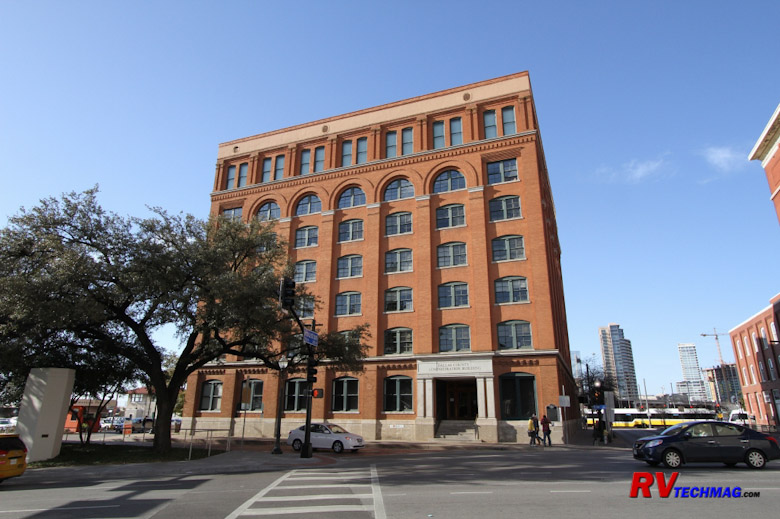
I remember Friday, November 22, 1963 quite well. I had just finished my lunch and was preparing to return to school when the
news rang out that President Kennedy had been shot in Dallas. School let out early that day and for the rest of the weekend everyone was glued to the
television as non-stop coverage began. It was a time that any American living at that time won't forget. It was inconceivable that this personable
President who led our country through some tough times was now dead.
President Kennedy arrived in Air Force One, landing at Love Field in Dallas at 11:37AM. He was joined by Texas Governor John
Connally, Vice President Johnson, and all their wives in preparation for the 1964 presidential campaign. An estimated 200,000 Dallas citizens greeted
the president's motorcade as it passed through downtown on the way to a sold-out luncheon for 2,600 people at the Dallas Trade Mart. As the motorcade
made the slow turn onto Elm Street in Dealey Plaza shots rang out. Eyewitness testimony led police to an immediate search of the railroad yards and
fenced area north of Elm Street, which later became known as the grassy knoll, as well as the Texas Book Depository.
The entire event became larger than life as additional twists and turns evolved.
A search of the Texas School Book Depository revealed a sniper's perch by a corner window ion the sixth floor. Stacked cases of
books were carefully arranged and three spent rifle shell casings were found on the floor at 1:15 PM. Further search revealed a rifle stuffed in a
corner behind some boxes near the exit stairwell. Employees were questioned by police but during a roll call, Lee Harvey Oswald, an employee of the
Depository who had begun work there the month before, was missing. Fingerprints on the rifle and on a stack of boxes in the sniper's perch were later
confirmed to belong to Lee Harvey Oswald, who had been seen on the sixth floor 35 minutes before the shooting and found in the building's lunchroom
two minutes after the shooting.
After the shooting of J. D. Tippit, a Dallas policeman, officers arrested Oswald after a scuffle inside the Texas Theatre at
1:50 PM. Over the next 24 hours more than 300 representatives from local, national and international news organizations descended upon the Dallas
Police headquarters to cover this major news event. On Sunday, as Oswald was being transferred from the city jail to the county jail, nightclub owner
Jack Ruby stepped out of the crowd and fatally shot Oswald. Ruby was convicted and sentenced to death but died three years later while awaiting an
appeal.
On November 29th, President Johnson established a special commission, headed by Supreme Court Chief Justice Earl Warren to
investigate the assassination of President Kennedy. The Warren Commission concluded that Oswald acted alone in killing the President. A 1979 report
commissioned by the House of Representatives added that a second gunman fired at the motorcade from the grassy knoll. This was supported by audio
tapes from the event as well as witness accounts by people present that day. This was repudiated in 1988 by the Justice Department but conspiracy
theories continue to evolve to this day.
|
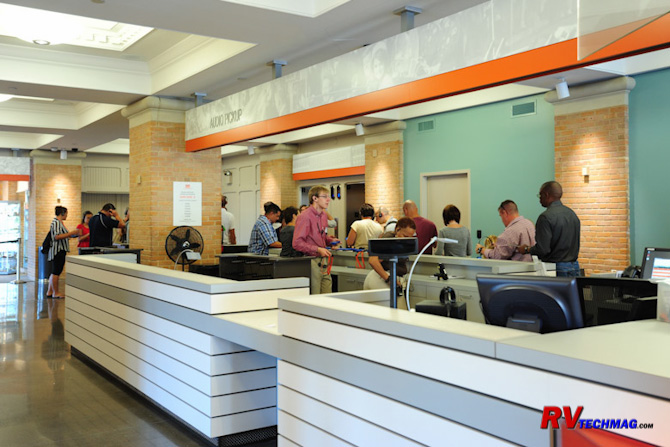
The visitor's entrance is in a museum addition. Visitors are equipped with headphones and audio devices to guide and explain the
museum exhibits.
|
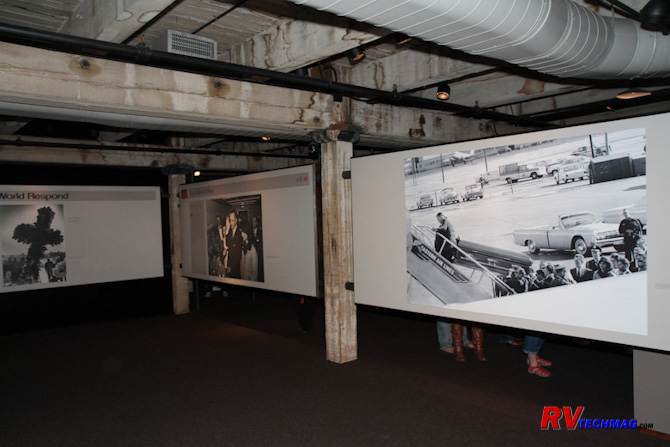
The tour begins with the history of President Kennedy, including his election campaign, the cold war and civil rights issues that he
dealt with as well as other events lading up to his trip to Dallas.
|
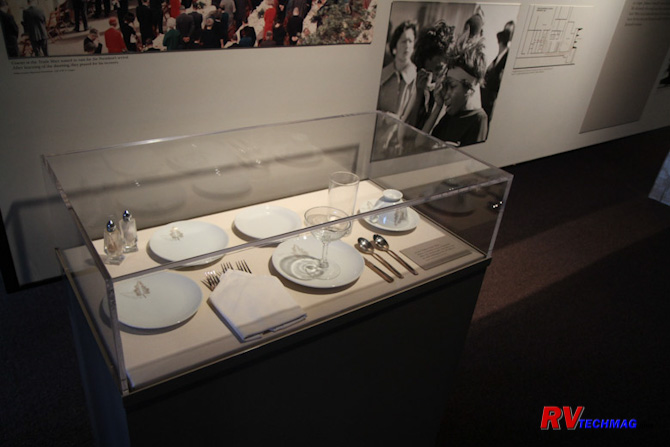
President Kennedy was headed for a luncheon with 2,600 people at the Dallas Trade Mart. This place setting was intended for President Kennedy.
|
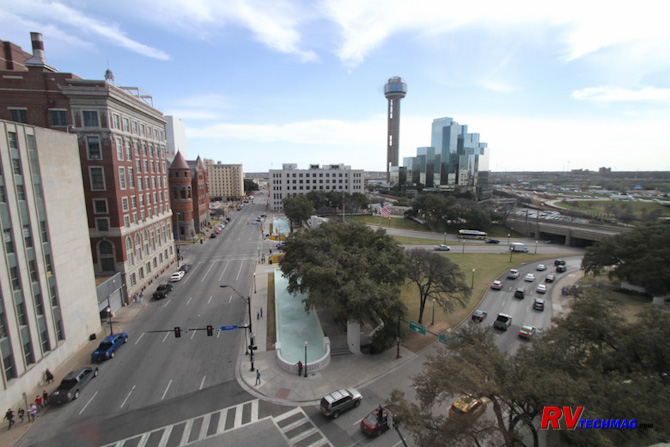
This view from the Sixth Floor shows the route the motorcade took, turning right onto Houston, heading towards the Texas Book Depository, making
a slow left turn onto Elm Street, where the fatal shots were fired.
The Museum
These events, as well as the life and legacy of John F. Kennedy are memorialized in the Sixth Floor Museum. The Texas Book
Depository was sold to the city of Dallas, who now uses the first five floors as administrative offices. In 1989, the Sixth Floor Museum at Dealey
Plaza opened to the public. Visitors enter via an annex and are fitted with audio guides and headphones that will guide you through the various
exhibits. Visitors ride an elevator to the sixth floor and enter the building through a former window. The tour begins by setting the scene for the
early 1960s. Items on display reflect the culture of the time, including social movements, political events and a fragment from the Berlin Wall.
Photographs and a short film document the life of President Kennedy. The Trip to Texas section follows and examines the reasons for Kennedy's trip
to Texas.
The Corner Window section recreates the sniper's perch as it was found on that fatal day. Cases of books are stacked in the
correct location and this area is closed off with glass to protect the original floor and the setting. There is no public access to that actual
window but the bank of windows to the side provides visitors with an opportunity to see Dealey Plaza much as Oswald would have seen it. The trees
have grown in the last 50 years so the clear line of sight that was present on that day no longer exists but it affords visitors a good
representation.
|
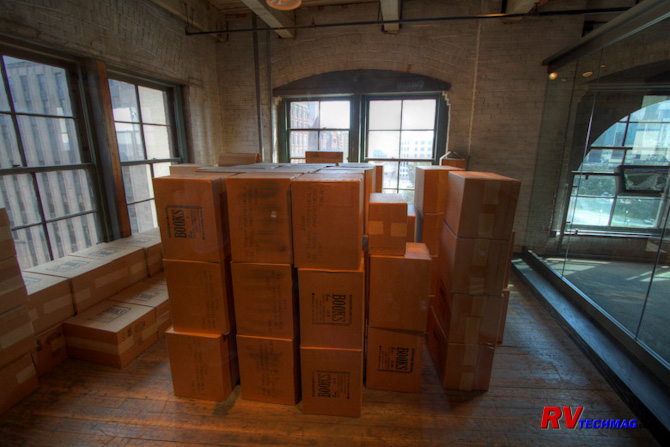
Oswald had strategically stacked cases of books in the corner of the sixth floor to hide his sniper's perch from anyone passing by. This
area has been restored to its original 1963 appearance and is surrounded by a glass enclosure.
|
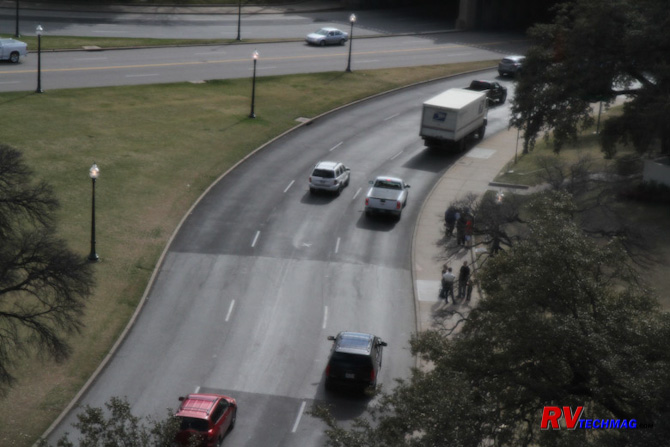
This view from the sniper's perch is similar to Oswald's, although the trees have grown and filled out during the last 50 years and masked
the clear view Oswald had in 1963.
|
The Crisis Hours section follows. An extensive collection of photographs and historic film footage documents everything that
followed. Photographs and films of Lyndon Baines Johnson's oath of office, JFK's funeral procession, Jack Ruby's shooting of Oswald and various
public reactions are all captured and on display. Included is the original radio broadcast by Pierce Allman, the first reporter to broadcast from
the Texas School Book Depository on November 22, 1963.
The Investigations section outlines the four official investigations, beginning with the local investigation in 1963,
outlining the participants and their findings. A 10' by 10' model of Dealey Plaza, prepared by the FBI for the Warren Commission in 1964 and on loan
from the National Archives is on display as is a collection of 13 cameras used in Dealey Plaza on November 22, 1963. Nearly 80% of the American public
believes that President Kennedy's death was the result of a conspiracy. A wall is also devoted to the various conspiracy theories that have surfaced
over the years and is devoted to the conspirators and their motives.
|
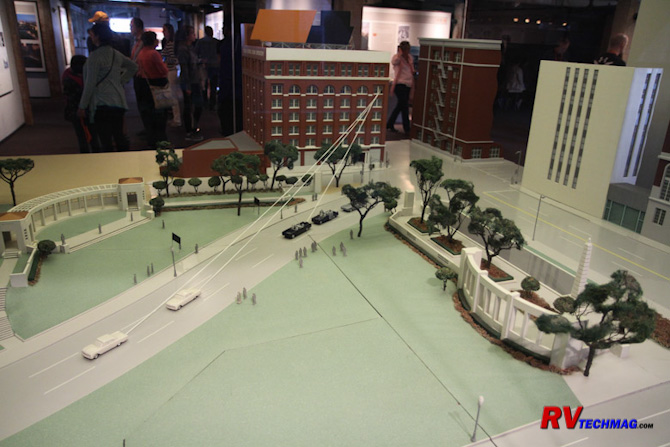
This is the actual 10 foot by 10 foot model of Dealey Plaza that the FBI created to assist in the Warren Commission's investigation.
It is on loan from the National Archives.
|
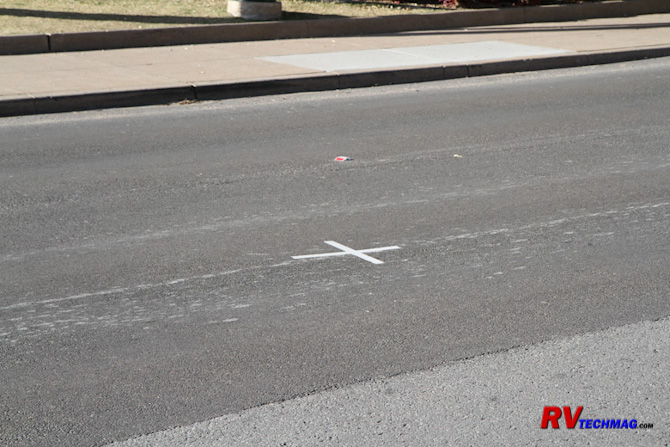
Two X marks on the pavement show the approximate locations of the limousine when the President was shot.
|
Final sections are devoted to President Kennedy's legacy. A film narrated by Walter Cronkite looks at the aftermath of the
assassination, his legacy of hope and the impact of his death. Lastly, an identical rifle to the one that Oswald used is on display where he hid it
behind some boxes before dashing down the staircase to the lunchroom. Oswald's actual rifle is in the FBI Museum in Washington, DC.
The museum also holds a first floor reading room which contains an extensive collection of books, magazines and newspapers
covering topics from Kennedy's life and legacy to conspiracy theories. A librarian can assist you in finding the correct material, which includes
rare and out of print items as well as close to 1,000 oral interviews. The Museum Store and Cafe is located across the street in the historic 501 Elm
building. Light lunches, snacks and beverages are available here as well as gifts, books and items by local artisans. A museum gift shop and rest
rooms are also located in the museum's entry at 411 Elm Street.
|
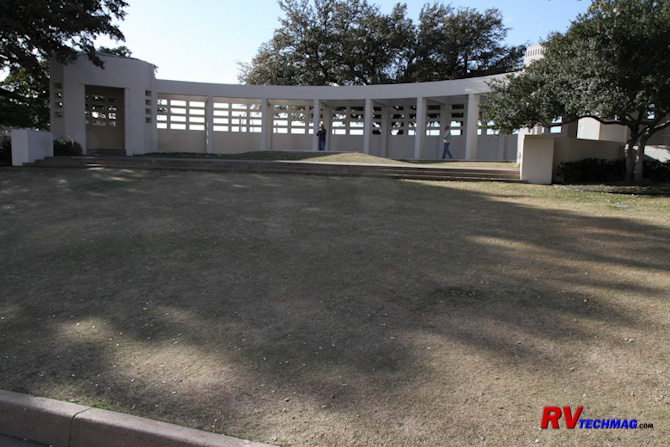
The grassy knoll next to the Texas Book depository is where Abraham Zapruder was filming the entire procession with his 8mm movie camera.
His film is the sole copy that recorded the assassination and was immensely helpful to the investigation.
|
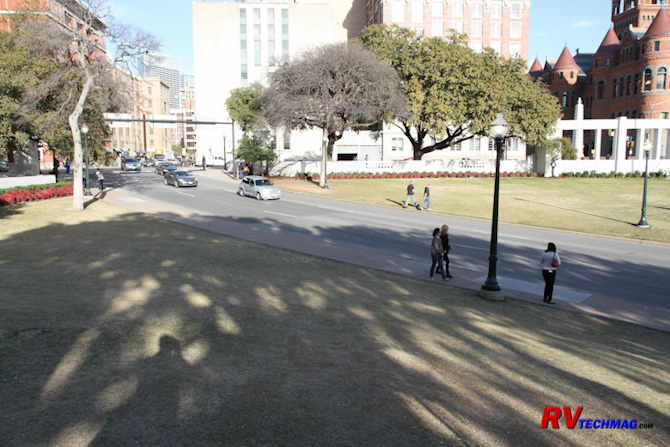
This image was taken from the same pedestal Abraham Zapruder was standing on when he filmed the motorcade, showing the same view that
Zapruder had of the event.
|
|
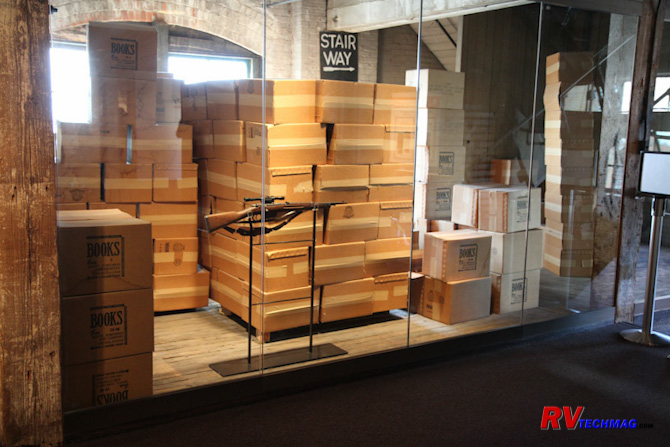
After the fatal shots were fired, Oswald hid his 6.5mm Mannlicher-Carcano rifle behind boxes near the stairwell, then
raced down the stairs to the lower level. This rifle is an identical copy to the one that Oswald used. The originl is
in the FBI Museum in Washington, DC.
|
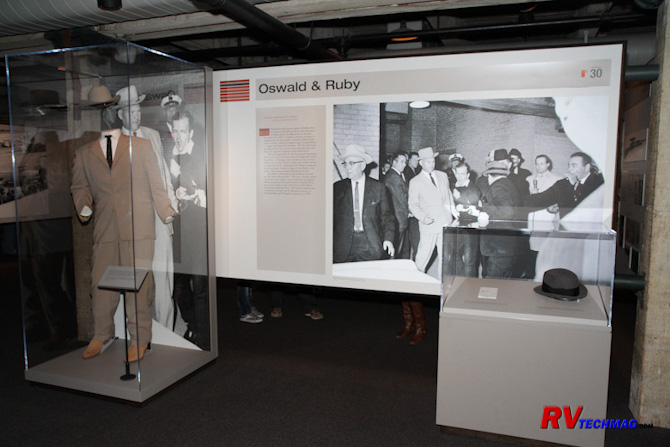
Jack Ruby shot Oswald on November 24, 1963 in the basement of the Dallas police station while being transported. The suit worn
by Jim Leavelle, the detective escorting Oswald, Jack Ruby's hat and the handcuffs used to shackle Oswald are on display in front of
Bob Jackson's Pulitzer Prize-winning photograph of the shooting.
|
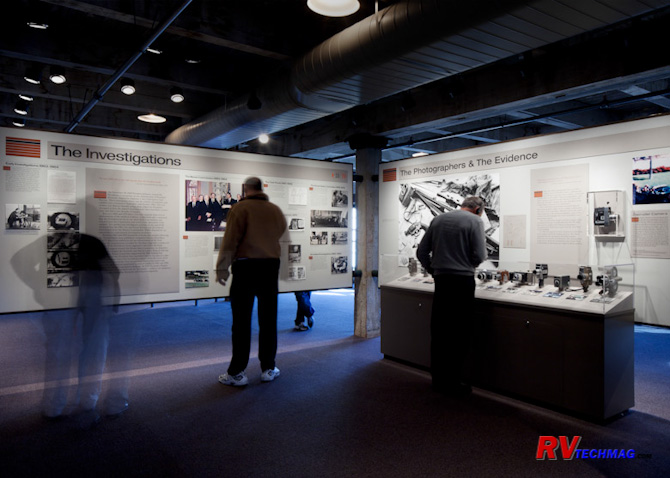
The museum is filled with a large number of artifacts and interpretive exhibits, such as this collection of cameras used during the event.
Surrounding Area
Dealey Plaza was created as a city park in the 1930s as a vehicular gateway to downtown Dallas. The Dealey Plaza National
Historical Landmark District, established in 1993, encompasses the plaza as well as the surrounding buildings, the triple underpass and the
railroad yards and historic switching tower. The grassy knoll rises from the north side of Elm Street to the edge of the stockade fence. Placards
identify the exact spot where Abraham Zapruder, a Dallas dress maker, filmed the entire event as the motorcade passed his location. Zapruder's film
footage was made available to authorities hours after the shooting and was crucial in helping them to understand and analyze the shooting. It is
the sole film footage of the actual assassination. A pair of taped Xs marks the two locations where President Kennedy was shot as the motorcade
passed by. The John F. Kennedy Memorial Plaza was designed by architect Phillip Johnson and dedicated in 1970. It is located two blocks away from
the museum and is an open air memorial depicting John F. Kennedy's spirit of freedom.
|
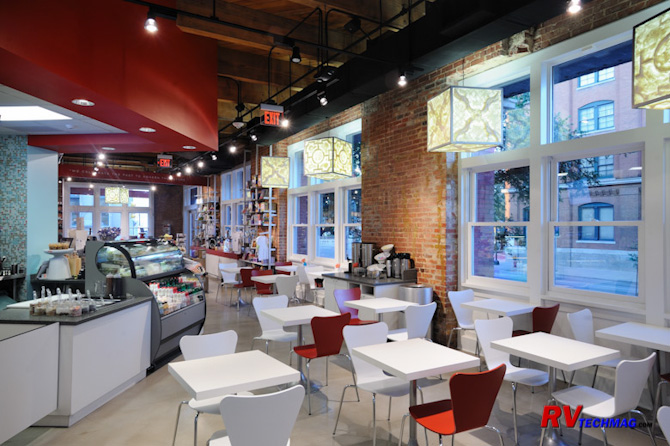
The museum's cafe provides lunches and light fare and is located adjacent to the museum.
|
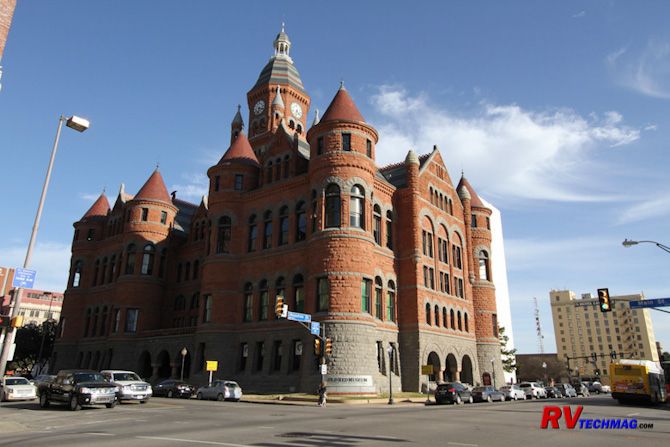
The Old Red Museum is across the street from the Sixth Floor Museum. The former Dallas County Courthouse, built in 1896, houses
exhibits of the early history of Dallas. It is a worthwhile stop.
|
|
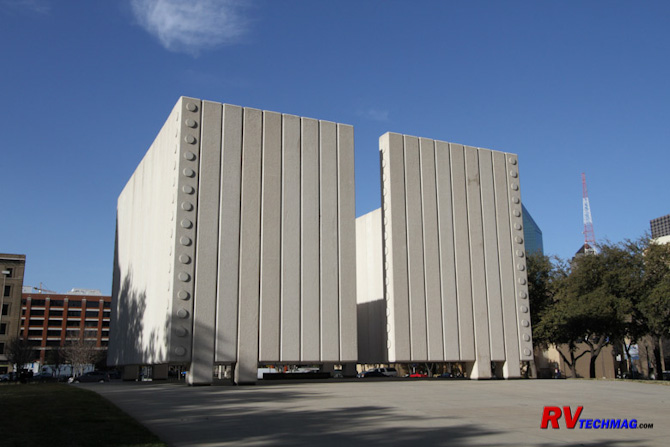
The John F. Kennedy Memorial Plaza is two blocks from the Sixth Floor Museum. It was designed by Phillip Johnson with an "open tomb"
design to symbolize President Kennedy's free spirit.
|
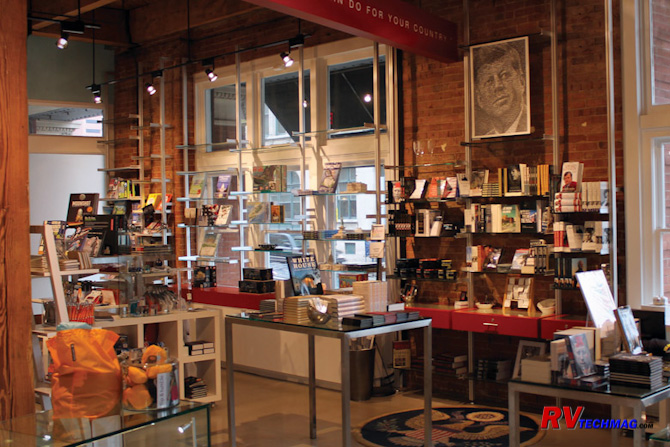
The museum's gift shop stocks an extensive selection of gifts and books pertaining to John F. Kennedy.
|
Tips for RV Travelers
The Sixth Floor Museum at Dealey Plaza is located in downtown Dallas. Numerous freeways afford easy access to the area but
parking for large vehicles such as RVs is not available. There are bus parking areas quite a way to the north but you'll be better off leaving your
RV at the RV park and taking your tow or towed vehicle into downtown Dallas. Passenger vehicle parking is available at the museum. There are
numerous RV parks in the area. In our case we stayed in nearby Terrell, Texas at Bluebonnet Ridge RV Park and found it was an easy 45 minute drive
into the downtown area.
An average of 320,000 people visit the museum each year so tickets are by timed entry in 30 minutes to eliminate overcrowding
and to ensure that you'll be able to comfortably enjoy your visit. On busy days some entry times may be sold out so consider buying your tickets
online in advance. The museum recommends 90 minutes for the average visit, although I would allow extra time to see Dealey Plaza and the area
surrounding the museum. Arriving early and avoiding busy weekend days always helps. Photographs may be taken outside but no photography is allowed
in the museum. Lockers are available in the visitor center to check any gear you don't want to carry while on the tour.
The Sixth Floor Museum is one of those stops that you should put on your bucket list. It's an interesting look at a tragic
event in America's history as well as a snapshot of that era and a testament to John F. Kennedy's eternal legacy.
Source
Sixth Floor Museum at Dealey Plaza
(214) 747-6660
www.jfk.org
Return to Home Page
If you enjoyed this article be sure to recommend RVtechMag.com to your friends, like us on Facebook or Twitter
or subscribe to our RSS feed.



|






















